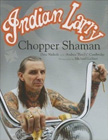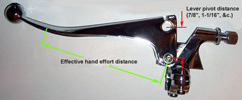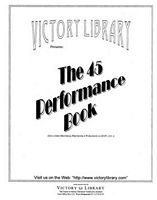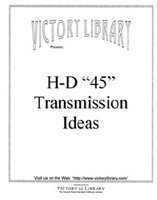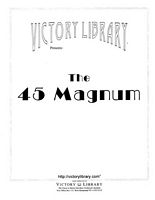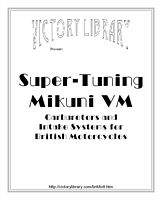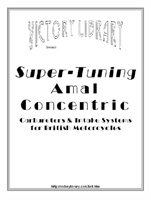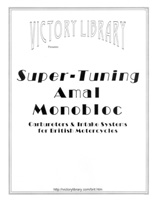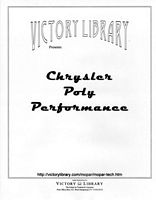 Motorcycle Chassis Design and Modification, Page 3 |
|||
 |
|
In addition to the original aluminum rims, a nice replacement (although slightly heavier and cosmetically different) are the 1962-69 Harley-Davidson Sportster optional rims, which are wider than the original British alloy WM3 rims, and have useful spoke drilling patterns. The part number is visible on the rim shoulder, and ends with the first year of use (such as 43001-62 = 1962, &c.). This should be between 1962-69. They are cheap on eBay (you may get the whole wheel cheaper than just the rim), and made in three common symmetrical drillings: » 18 & 19” front: laces to a full-width hub, like the pre-1971 Triumph, BSA front drum, &c. » 18” rear: laces to a spool hub, like the BSA quick-change, pre-1971 Triumph rear drum, &c. » The similar disc and drum 1970-* CM (not WM) alloy rims are not safe to use with conventional tires and must be avoided. The part numbers of the unsafe rims include: 43010-70, 43008-70 & 42998-74. Tires Tire companies claim a shelf life of two to four years for tires. After that time, the tread hardens from ozone exposure, and also from unltra-violet rays if they’re exposed to sunlight. In addition, they “gas out”, as the petroleum fractions used to alter the rubber hardness evaporate. If you want to keep it more than a couple of years, use a big garbage bag and store indoors in a cool place. If it doesn’t stink any more, it’s getting too old. The extra traction is not something you use all the time, in fact it may never make a difference (and remember that more footprint may reduce wet grip, which also depends on groove width etc.). However: when you go to a larger (metric, low aspect ratio profile) tire not only do you disturb the rake, trail, ride height, ground clearance and weight distribution, the new tires are generally heavier and the extra weight is unsprung (= bad) weight, and will affect handling, traction on ripply surfaces and ride comfort all the time. Remember: the ideal amount of unsprung weight is 0%, and a lighter bike (compared to a UJM) suffers more. If you use the same rim width (WM2, &c.), you don’t get much extra tread contact as the manufacturer advertises since the carcass “rounds”more to fit the narrow rim. Wider rim (WM2.5 for 110/90-18)? More money, more weight. A larger tire doesn’t necessarily mean better handling, traction (not the same thing) etc. Unless another variable is changed (compound, rim width, tread pattern), wet grip is reduced. Is that what you want? The “balance”that the better British bikes have is not, NOT an accident, and there are subtle changes that occur with even small differences in tire width, width bias, height, pressure, tread design etc. Many manufacturers have changed head angle by less than 1 degree, wheelbase by 1/2“, swingarm length by 1/2” (with the same wheelbase), and not because all prior bikes crashed. What do you know that they don’t? Why did they spend money when “you can’t tell the difference”? I've been playing with this stuff for 40 years, and “leave it alone”is frequently the best suspension advice you can get. Ever hear how badly the famous 1972 H2 Kawasaki (“hinge in the middle”) 750 triple was? I found out exactly how to straighten it out - 100 lbs. of ballast in back of me, which should have made everything worse. I've ridden a modern bike (discs, Konis, etc.) that was “improved”by lowering it on both ends equally (to within about 1/8”) with the same spring rate and tire size, and it wants to fall over and is very nervous at all speeds - despite lower C of G. Tried tire pressure, spring pre-load, shock settings, sliding the tubes in the trees, fork oil viscosity, NFG. No one knows what to do, except change it all back. Chain drive a slightly smaller chain will reduce drive-line losses. Instead of the stock #530 chain (3/8”wide by .400”diameter roller, 5/8”pitch), we're going to try 525 chain (5/16”wide by .400”roller, 5/8”pitch) running on 520 sprockets (¼”by .400”, 5/8”) for minimal friction at the sprocket. An O-ring chain has higher internal friction. If I’m not completely certain that a master link’s spring clip has returned to absolutely flat (normal) condition I discard it. Re-installing a spring clip that already wants to jump off is a DNF waiting for the worst moment to happen. use “figure 8”chain, weighs less than late straight link chain If you can get a rear sprocket with a prime number of teeth, the chain will last orders of magnitude longer. My bike, as is, but with a 46T (stock) rear sprocket and a new Tsubaki chain, well and regularly lubed and adjusted got less than 10K miles. After fitting the 43T (one-piece drum and sprocket) rear sprocket with a new chain of the same type, I now have about 22K miles with adjustments made MUCH less regularly. I found that the original chain wore in two places exactly equidistant from each other and I attribute it to harmonics in the drive. A prime number of teeth on the rear seems to eliminate this characteristic and gives much better wear characteristics and smoother operation. As a guess, if you can choose two sprockets that have no, or few, factors in common, it would allow for max. chain life. Example...19 and 43 are both prime and that would be ideal, but for the lower than desired gearing. 20 and 50 would be bad as both share 2, 5, 10 as factors. 20 and 43 have no common factors (except 1, and that doesn’t count). Having a prime on the front probably is almost as good as on the rear, but I haven’t tested this. Rules, errors, non-sequiturs, omissions, &c. 1. they didn’t list “number plate must be parallel to fork tube” (as in 10.4.3A/k). Free fairing. 2. no limit on number of gears in the original case 3. carb limited only by type & size - no limit on manifold type, length, volume. Leaves the door open for (example) a TR6 head for the better ports with parallel separate runners ending in a plenum with 2 X 930 Concentrics - huge increase in air available. 4. “production frame”, but no wording I can find about how the components are positioned in the frame. Example: re-locating a T120 motor forward and up increases forward weight distribution, weight transfer on acceleration, ground clearance for pipes, carb clearance to frame tube. Even 1/2” (all original mount holes elongated and welded shut) will make a difference. 5. I don’t know whether a bolt-on accessory will be considered a modification, but there are areas where a frame can be improved with even a clamp-on bar. 6. minor cheating: extend swing-arm to change weight distribution, dissect swing-arm to “slug” the main tubes where they intersect the crossmember, move shock mount back to give more progressive action on compression. 7. nothing in carb restrictions besides ID - allows big taper velocity stack, internal blending, replica UFO, etc. If it were important, I could put a Mono jet block and slide into a 930 body. 8. all these rules foolishly do leave out something that is (IMHO) essential and is included in many other sanctioning body rules: “all air entering the engine must pass through the carburetor’s throat in conventional manner”. Some of you know what I mean here, I won’t elaborate. The unsprung weight is the most important, it means less spring and shock is needed for sustained traction, less accidental oversteer in a bumpy corner (as the wheel is unloaded after it goes over a bump). Almost no inertial since the wheel RPM is fairly slow, but it’s all positive. Sorry if I’m explaining things you already know, but something as small as reducing handlebar width 1” on each side, removing 1” from the seat foam, lightest weight oil in the transmission and primary, lightest engine oil that gives safe pressure at operating speed are all not merely useful but necessary when you’re down on power in a competitive class. If a top speed test isn’t practical, some useful A-B high speed tests can be done with a measured distance, stopwatch and a vacuum gauge. If you do the same speed each time but vacuum goes up the change was helpful. It doesn’t say the plate has to be the same size, or that the carburetor may be bigger - those are both “assumed”. What would help: “either the carburetor must conform to the maximum size requirement, or, if the carburetor exceeds the maximum size a restrictor plate of this same size must be fitted between the carburetor body and the engine”. And what if it’s mounted in a section of the manifold (which may be modified in Sportsman) that has a 14 degree taper before and after it? Where does it even say the plate must be mounted between the carburetor and the engine? Why not inside the carburetor? Why not at the very extreme end of the snorkel leading into the airbox? Their response: “everyone knows what we mean, there’s nothing wrong with it”. Decoded: “none of our friends have either thought of these things, or been beaten by someone who did”. What does “vehicle in motion” mean? I can’t think of anything except traction control that only works with vehicle in motion. Does that mean all manually advance spark levers (the only equipment on all H-D until 1964), auto-advance mechanisms, Boyer, and H-D VOES systems are illegal? Aren’t they “any other means”? Or did they mean traction control, knock suppression, advance curve based on gear selection etc. NOT under rider’s control? Flywheel inertia as a tuning tool for flat track Flywheel weight as a traction-tuning tool is very subjective, and how much you need is a function of total chassis + rider weight, weight distribution, how much bias the rider can exert by moving on the seat, wheelbase, tire tread type and pressure, etc. One advantage of more weight is that closing the throttle is less likely to lock the wheel, but of course nailing the throttle won’t be as useful either. Machines down on power or too heavy sometimes have to reduce flywheel weight just to able to set up for drifts - absolute traction becomes less important that initial attitude for corners. A rotor, or rotor-like inertia storage device could extend outside the primary but this may be illegal, require a cover (expanded mesh), and reduce your maximum lean angle, and of course ruin the crank if you go down. Benefit: not only more weight, but the ability to tune for traction in between heats with minimal work - less than R&R a tire. The external device(s) must be neutral balanced so they are not position-sensitive and can be swapped. The least dead weight will be from calculating the largest OD that’s legal/safe, then make several discs thick enough to be safe (1/4” steel? center, 1/2” hub?) with all the weight concentrated at the rim by making it thicker. The rim weight need not be continuous as long as it’s symmetrical - a 1/4” disc can have bob-weights welded or securely bolted to the rim area in 2, 3, 4, etc. places before balancing rather than lathe fabrication of a complex 3-dimensional shape. Any bolts should be Ny-Loc’d, safety-wired, etc. and must have only the grip length in shear. Remember, if this comes off at speed it can easily kill you. Disc 1 is blank (no rim), disc 2 has 1 lb. rim, disc 3 has 2 lbs. etc. An external bearing to support this sounds nice but remember that it shouldn’t even touch the bearing if it’s running properly, and if it bends, damaged etc. it will probably kill the crank and/or drive bearing quickly. Even though it’s probably more money, it should be neutral balanced separately for 3 reasons: 1. it’s now unimportant whether it’s there or not. 2. the crank doesn’t like having compensating counterweight hung away from the imbalance - under ideal circumstances the journal itself would be a black hole and have negative weight exactly centered on the rod. 3. an eccentric weight is more likely to come off. If using a charged battery you may consider using extra known-to-be-dead rotors as alternate weights by drilling them out etc. - same rule, remove the weight at the rim or turn down the OD. Easier than making a weight since it already has the drive. |
What’s Related? | |||||
2LS brake |
British | Convert H-D |
Sprung vs. |
Aluminum |
Flywheel weight |
See these other Victory Library booklets | |||||||||||
I’m trying to locate some people I used to know; please click here for more details. Thanks! | |||||
British |
British |
Victory Library |
Harley-Davidson |
Mopar | |
